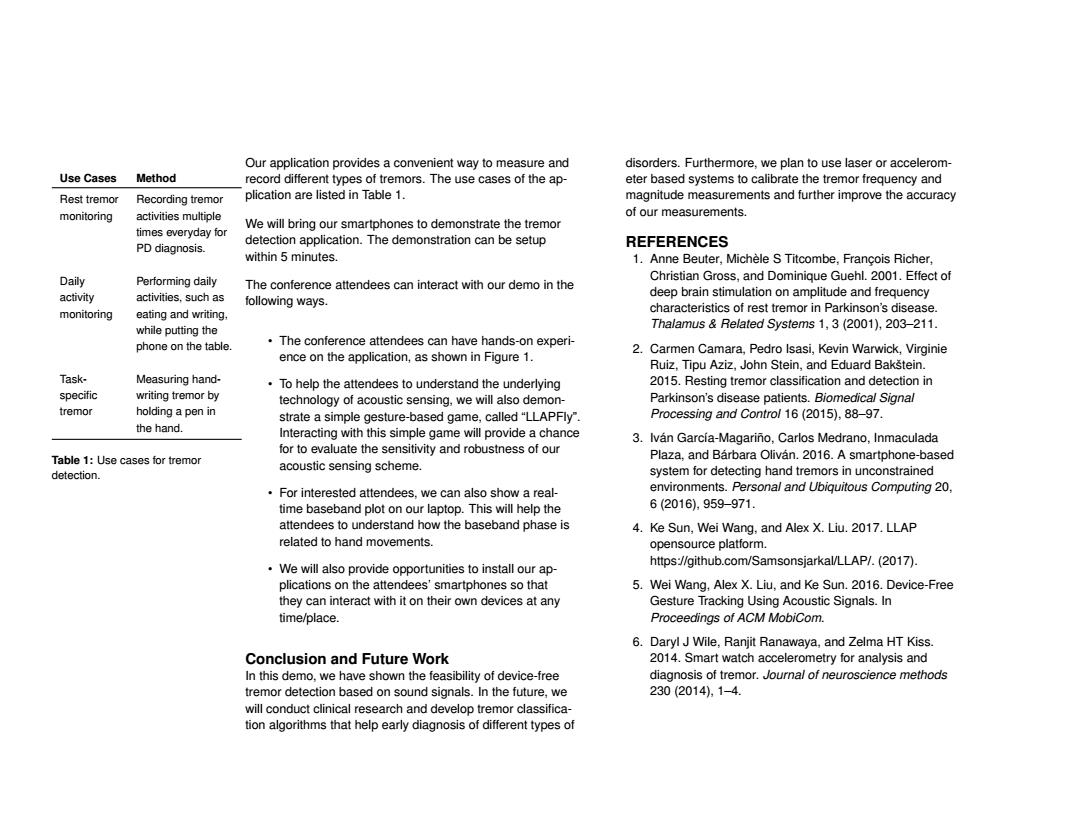正在加载图片...

Our application provides a convenient way to measure and disorders.Furthermore,we plan to use laser or accelerom- Use Cases Method record different types of tremors.The use cases of the ap- eter based systems to calibrate the tremor frequency and Rest tremor Recording tremor plication are listed in Table 1. magnitude measurements and further improve the accuracy monitoring activities multiple of our measurements We will bring our smartphones to demonstrate the tremor times everyday for PD diagnosis. detection application.The demonstration can be setup REFERENCES within 5 minutes. 1.Anne Beuter,Michele S Titcombe,Francois Richer, Daily Performing daily Christian Gross,and Dominique Guehl.2001.Effect of The conference attendees can interact with our demo in the activity activities,such as deep brain stimulation on amplitude and frequency following ways. monitoring eating and writing. characteristics of rest tremor in Parkinson's disease. while putting the Thalamus Related Systems 1,3(2001),203-211. phone on the table. The conference attendees can have hands-on experi- ence on the application,as shown in Figure 1. 2.Carmen Camara,Pedro Isasi,Kevin Warwick,Virginie Ruiz,Tipu Aziz,John Stein,and Eduard Bakstein. Task- Measuring hand- To help the attendees to understand the underlying 2015.Resting tremor classification and detection in specific writing tremor by technology of acoustic sensing,we will also demon- Parkinson's disease patients.Biomedical Signal tremor holding a pen in strate a simple gesture-based game,called"LLAPFly". Processing and Control 16(2015),88-97. the hand. Interacting with this simple game will provide a chance 3.Ivan Garcia-Magarino,Carlos Medrano,Inmaculada for to evaluate the sensitivity and robustness of our Table 1:Use cases for tremor Plaza,and Barbara Olivan.2016.A smartphone-based acoustic sensing scheme. detection. system for detecting hand tremors in unconstrained For interested attendees,we can also show a real- environments.Personal and Ubiguitous Computing 20. time baseband plot on our laptop.This will help the 6(2016),959-971. attendees to understand how the baseband phase is 4.Ke Sun,Wei Wang,and Alex X.Liu.2017.LLAP related to hand movements. opensource platform. https//github.com/Samsonsjarkal/LLAP/.(2017) We will also provide opportunities to install our ap- plications on the attendees'smartphones so that 5.Wei Wang,Alex X.Liu,and Ke Sun.2016.Device-Free they can interact with it on their own devices at any Gesture Tracking Using Acoustic Signals.In time/place. Proceedings of ACM MobiCom. 6.Daryl J Wile,Ranjit Ranawaya,and Zelma HT Kiss. Conclusion and Future Work 2014.Smart watch accelerometry for analysis and In this demo.we have shown the feasibility of device-free diagnosis of tremor.Journal of neuroscience methods tremor detection based on sound signals.In the future,we 230(2014),1-4. will conduct clinical research and develop tremor classifica- tion algorithms that help early diagnosis of different types ofOur application provides a convenient way to measure and record different types of tremors. The use cases of the application are listed in Table 1. We will bring our smartphones to demonstrate the tremor detection application. The demonstration can be setup within 5 minutes. Use Cases Method Rest tremor monitoring Recording tremor activities multiple times everyday for PD diagnosis. Daily activity monitoring Performing daily activities, such as eating and writing, while putting the phone on the table. Taskspecific tremor Measuring handwriting tremor by holding a pen in the hand. Table 1: Use cases for tremor detection. The conference attendees can interact with our demo in the following ways. • The conference attendees can have hands-on experience on the application, as shown in Figure 1. • To help the attendees to understand the underlying technology of acoustic sensing, we will also demonstrate a simple gesture-based game, called “LLAPFly”. Interacting with this simple game will provide a chance for to evaluate the sensitivity and robustness of our acoustic sensing scheme. • For interested attendees, we can also show a realtime baseband plot on our laptop. This will help the attendees to understand how the baseband phase is related to hand movements. • We will also provide opportunities to install our applications on the attendees’ smartphones so that they can interact with it on their own devices at any time/place. Conclusion and Future Work In this demo, we have shown the feasibility of device-free tremor detection based on sound signals. In the future, we will conduct clinical research and develop tremor classification algorithms that help early diagnosis of different types of disorders. Furthermore, we plan to use laser or accelerometer based systems to calibrate the tremor frequency and magnitude measurements and further improve the accuracy of our measurements. REFERENCES 1. Anne Beuter, Michèle S Titcombe, François Richer, Christian Gross, and Dominique Guehl. 2001. Effect of deep brain stimulation on amplitude and frequency characteristics of rest tremor in Parkinson’s disease. Thalamus & Related Systems 1, 3 (2001), 203–211. 2. Carmen Camara, Pedro Isasi, Kevin Warwick, Virginie Ruiz, Tipu Aziz, John Stein, and Eduard Bakštein. 2015. Resting tremor classification and detection in Parkinson’s disease patients. Biomedical Signal Processing and Control 16 (2015), 88–97. 3. Iván García-Magariño, Carlos Medrano, Inmaculada Plaza, and Bárbara Oliván. 2016. A smartphone-based system for detecting hand tremors in unconstrained environments. Personal and Ubiquitous Computing 20, 6 (2016), 959–971. 4. Ke Sun, Wei Wang, and Alex X. Liu. 2017. LLAP opensource platform. https://github.com/Samsonsjarkal/LLAP/. (2017). 5. Wei Wang, Alex X. Liu, and Ke Sun. 2016. Device-Free Gesture Tracking Using Acoustic Signals. In Proceedings of ACM MobiCom. 6. Daryl J Wile, Ranjit Ranawaya, and Zelma HT Kiss. 2014. Smart watch accelerometry for analysis and diagnosis of tremor. Journal of neuroscience methods 230 (2014), 1–4